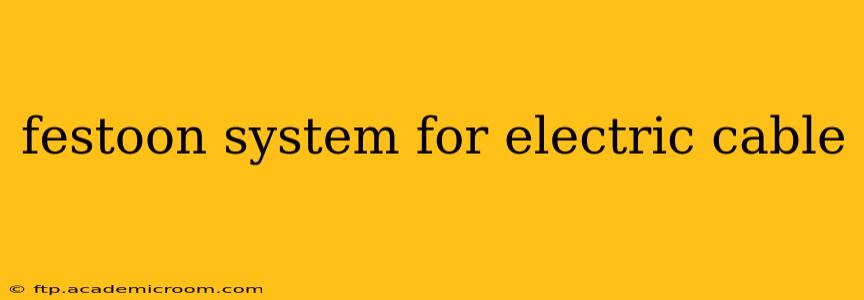Festoon systems are crucial for safely and efficiently managing electrical cables in dynamic environments where equipment moves frequently. From industrial settings to stage productions, a well-designed festoon system ensures continuous power supply while protecting cables from wear and tear. This comprehensive guide delves into the intricacies of festoon systems, addressing common questions and providing valuable insights for optimal implementation.
What is a Festoon System for Electric Cables?
A festoon system is a method of suspending and guiding electrical cables, hoses, and other utilities above a working area. It typically involves a series of trolleys running along a track, allowing the cables to move freely with the equipment they power without tangling or being damaged. This contrasts with fixed cable runs, which are unsuitable for situations requiring frequent movement. The system is designed to handle the weight and movement of the cables, preventing sagging, abrasion, and premature failure. Key components usually include:
- Track: The supporting structure, typically made of aluminum or steel, along which the trolleys travel.
- Trolleys: These carry the cables and are designed to move smoothly along the track.
- Cable Supports: These help to keep the cables organized and prevent them from snagging.
- End Stops: These prevent the trolleys from running off the track.
- Cables and Hoses: The utilities supported by the system.
What are the Benefits of Using a Festoon System?
Festoon systems offer numerous advantages over other cable management methods:
- Increased Safety: Reduces the risk of cable damage, tripping hazards, and electrical shocks.
- Improved Efficiency: Allows for smooth and continuous operation of equipment, minimizing downtime.
- Extended Cable Lifespan: Protects cables from abrasion, kinking, and other forms of damage, extending their lifespan.
- Enhanced Flexibility: Allows for easy movement of equipment without disconnecting cables.
- Cost-Effective: While the initial investment might seem higher, the long-term cost savings from reduced cable replacement and downtime can be significant.
What are the Different Types of Festoon Systems?
Festoon systems come in various configurations, each tailored to specific application needs:
- Horizontal Festoon Systems: Ideal for applications requiring cable movement along a straight line.
- Vertical Festoon Systems: Used for applications where cables need to be raised and lowered.
- Curved Festoon Systems: Designed for applications with curved or angled cable paths.
- Heavy-Duty Festoon Systems: Built to withstand extreme conditions and heavier cable loads.
- Lightweight Festoon Systems: Suitable for lighter applications where minimal weight is a priority.
How Much Does a Festoon System Cost?
The cost of a festoon system varies considerably depending on several factors:
- Length of the track: Longer tracks naturally increase the overall cost.
- Type of track material: Aluminum tracks are typically less expensive than steel tracks.
- Number of trolleys: More trolleys translate to a higher cost.
- Type of cable supports: The complexity and design of cable supports affect the price.
- Additional features: Features such as integrated lighting or cable strain relief systems add to the cost.
How Do I Choose the Right Festoon System for My Needs?
Selecting the appropriate festoon system involves careful consideration of several key factors:
- Cable Type and Weight: The system must be capable of supporting the weight and type of cables being used.
- Movement Range: The track length and configuration must accommodate the required movement range.
- Environmental Conditions: The system should be compatible with the operating environment (temperature, humidity, etc.).
- Budget: Balancing functionality and cost is crucial.
- Maintenance Requirements: Consider the ease of maintenance and replacement of components.
What are the Common Maintenance Needs of a Festoon System?
Regular maintenance is vital for the longevity and safe operation of a festoon system:
- Regular Inspection: Check for signs of wear and tear on the track, trolleys, and cables.
- Lubrication: Periodically lubricate moving parts to ensure smooth operation.
- Cable Replacement: Replace damaged or worn-out cables promptly.
- Cleaning: Keep the system clean and free of debris.
Where Can I Find Festoon Systems?
Festoon systems are available from various industrial supply companies and specialized manufacturers. Online searches for "festoon systems" or "cable management systems" will yield a multitude of suppliers.
This guide provides a solid foundation for understanding festoon systems. Remember to consult with a qualified professional for specific applications and installations to ensure optimal safety and functionality.
